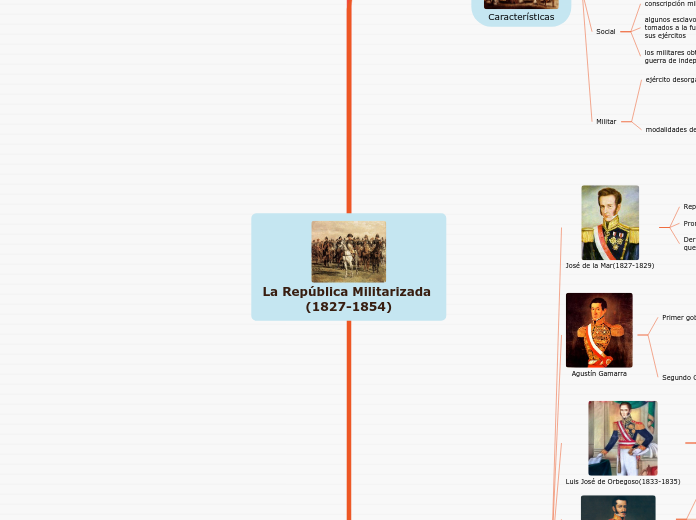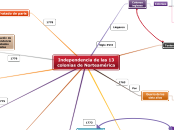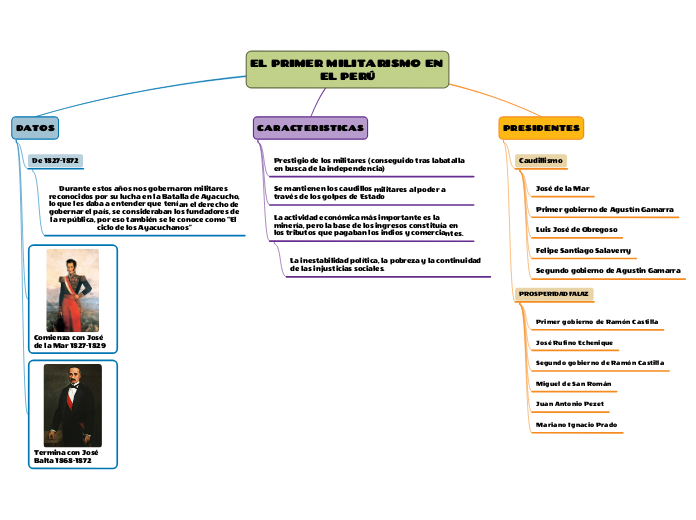La República Militarizada (1827-1854)
To name your story, you have to think about the overall message and what you want your audience to understand from the story. Also, make it relevant and easy to remember.
Gobiernos
The ending of a story is essential. We all know that if the ending is weak, what happened before loses its importance. So make it unpredictable, but fair. A resolved ending answers all the questions and ties up any loose threads from the plot.
Rufino Echenique
caracterizado por un alto grado de corrupción
impulsó la colonización de la selva central
continuó con la compra de buques y ferrocarriles
Primer gobierno de Ramón Castilla(1845-1851)
obras públicas
compra de busques de guerra
Construccion de ferrocarril
Primer presupuesto nacional
pago de la deuda externa e interna
auge económico
aprovechó los ingresos de exportación del guano
de Anarquía Militar (1841-1845)
etapa de caos y convulsión política
ningun gobierno logra consolidarse
Manuel Ignacio de Vivanco (1843-1844)
Juan Figuerola (15-19 marzo 1843)
Juan Francisco Vidal (1842-1843)
Juan Cristónomo Torrico (agosto-octubre 1842)
Manuel Menéndez (1841-1842)
Andrés de Santa Cruz (1836-1839)
se establecieron tres estados
Bolviano
Surperuano
Norperuano
Declara la Ley de los Puertos Libres
Arica
Paita
Callao
Líder y jefe supremo de la Confederación
Felipe S. Salaverry (1835-1836)
Subtopic
Guerra a muerte contra Bolivia y el proyecto de la Confederación
Se alzó en armas contra Orbegoso
Luis José de Orbegoso(1833-1835)
Primera Guerra Civil
contra el general Pedro Pablo Bermúdez
Constitución liberal de 1834
elegido por la Convención Nacional
Agustín Gamarra
This is the closure section of the story.
See examples of possible outcomes below:
- all problems have been solved
- it's clear how each one of your characters ends up
- your main character is transformed by the challenge
Segundo Gobierno (1839-1841)
Inicio de la exportación guanera
Constitución de Huancayo
Primer gobierno (1829-1833)
Try answering these questions to come up with a closure:
- Have all the problems been solved?
- Is there a clear picture of what happens with each character in the story?
- Has the challenge transformed your main character?
- How do the characters feel in the end?
Firma de Tratado Pando-Novoa con Ecuador
firma del Tratado de Paz Larrea-Gual con la Gran Colombia
se suscitaron una serie de revueltas a las que enfrentó
representó el poder ejecutivo fuerte
José de la Mar(1827-1829)
This is the moment when the main character surpasses the last obstacle and finally faces their greatest challenge.
The climax usually follows one of these patterns:
- realization
- resolution
- choice
Type in your answer.
Derrota en la guerra contra la Gran Colombia, razón por la que huye del país.
Promulgó la Constitución Liberal de 1828
Representó un gobierno débil
Características
The middle of the story is where you add layers of complications that will lead to the end. Reveal more about the character's journey. Did their personality go through changes? How did they overcome the challenges? And as you build up the story’s central conflict, make it more personal to that character. Also, from the middle act, you have to lead into the final act.
Militar
modalidades de ingreso
voluntariado
como forma de ascenso social (meritocracia)
reclutamientos forzosos (levas)
escalafón de notables locales
terratenientes obtenían rápidamente altos grados militares
que les permitía una especie de poder político
soldado distinguido
los hijos de familias notables ostentaban una educación castrense
ejército desorganizado y dividido
como consecuencia de la rivalidad caudillista
Social
los militares obtuvieron tierras como pago por la guerra de independencia
algunos esclavos que huían de sus amos eran tomados a la fuerza por los caudillos para integrar sus ejércitos
conscripción militar
reclutamiento abusivo de los indígenas
Económico
Your character(s) need(s) motivation in order to solve the challenge(s).
Impuestos base de los ingresos
There wouldn't be any tension and excitement in your story if there weren't any obstacles in your character's way.
alcabalas
aduanas
contribución indígena (tributo)
A story is nothing more than a character overcoming a series of difficulties to reach the desired goal. Obstacles usually create suspense and conflict. In overcoming obstacles, there is growth: weak becomes strong; hatred turns into love; sadness into happiness; wrong into right; lies into truth; or evil becomes good.
See a few examples below:
- stopping a meteor
- finding a killer
- finding love
eliminado por Ramón Castilla en 1854
actividades principales
Secondary characters might also have motives that lead them to cross paths with the main character or which might trigger them to help the main character.
hacia la mitad del siglo, la explotación del guano
minería
dependencia imparcial de Inglaterra
Why does your character need to confront this challenge? What does he/she expect to accomplish by solving it?
See a few examples:
- will marry in 3 days
- can fix the mistakes of the past
como motivo de la inestabilidad
Político
Each story has a main character and that character usually needs to solve a problem or challenge. The character's challenge is the one that creates tension throughout the story.
Ejecutivo fuerte
el legislativo cedía atribuciones
Segundo debate político
Type in any other challenges which other characters in the story need to face.
liberales
defensa del legislativo
autoritarios
defensa del ejecutivo
Gobernaron los militares que participaron en la batalla de Ayacucho
In most stories, there are 3 challenges. The number 3 is a mystical number symbolizing completeness. Try to come up with interesting challenges with which your character needs to struggle.
See a few examples below:
- turns into a werewolf at night
- is sent back in time
a través de golpes de estado
Origen
In the beginning of the story (or the exposition), you will need to introduce the setting and characters. You might also want to introduce the main conflict. This part of the story is important because it gives the reader necessary background information and maybe even a first insight into a character’s personality.
Antecedentes
The setting (time & place) of a story can change throughout the plot.
Los caudillos
The weather is an important element in your story because it can highly influence the ambiance and the mood of the characters.
concibieron la modalidad de gobierno dejada por Bolívar
Does your story include catastrophic weather? See a few suggestions below or add your own:
- hurricane, earthquake, storm, etc
de dictadura republicana
amasaron fortuna a través
de la tierra que obtuvieron como pago por
participar en la guerra de independencia
Dictadura de Bolívar
The time of the story can also change. It can describe the event of a single day or can include an entire year's plot. Anyway, don't forget to mention it.
Ejecutivo fuerte en desmedro de los otros dos poderes
Facultades sin restricciones
Dictadura republicana
Primer golpe de estado 1823
Your story can take place wherever your imagination will take you to.
For example: in an elevator, in an enchanted forest, etc. Don't forget to give details of the environment each time the setting changes, otherwise, the story can be confusing. Also, mention the seasons as each of them has unique weather and events.
Proclamación de José de la Riva Agüero como primer presidente.
Encabezado por Santa Cuz
Surge como respuesta a la anarquía de inicios de la república y ante el vacío de poder.
Characters are essential to a good story. Usually, the protagonist(s) is/are the most affected by the plot. Introduce a character by focusing on their actions, interests, and occupation, as the physical appearance doesn't make a difference in most cases.
finalidad: establecer un gobierno fuerte que busque
Type in the name of your character.
Liderazgo en guerras con el exterior
What is your character's main goal?
fight Evilfind lovedefeat his/her enemyrule the worldmake friendstime travelmake an awesome discoveryOther
Estabilidad política
Which traits best describe the character's personality? Choose more if necessary:
introvertedloyalkindindependentquick-thinkingadventuresomeidealisticsweet-naturedcalmrisk-takercreativewittystrictfussyweirdclumsyharshaggressivecarelessclingingcowardlycrueldeceitfulimpulsiveOther
El orden interno
Choose the type of your chacter:
Protagonist (main character)Antagonist (main character's opponent)Flat (stereotypical character)Round (his/ her personality develops throughout the story)Static (doesn't evolve as a person throughout the story)Dynamic (dramatical change in personality)Confidant (the main character trusts him/ her)Foil (contrasting character who enhances the personality of another character)Other










